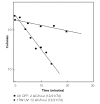The history of ultraviolet germicidal irradiation for air disinfection
- PMID: 20402193
- PMCID: PMC2789813
- DOI: 10.1177/003335491012500105
The history of ultraviolet germicidal irradiation for air disinfection
Abstract
Public health concerns such as multi- and extensive drug-resistant tuberculosis, bioterrorism, pandemic influenza, and severe acute respiratory syndrome have intensified efforts to prevent transmission of infections that are completely or partially airborne using environmental controls. One such control, ultraviolet germicidal irradiation (UVGI), has received renewed interest after decades of underutilization and neglect. With renewed interest, however, come renewed questions, especially regarding efficacy and safety. There is a long history of investigations concluding that, if used properly, UVGI can be safe and highly effective in disinfecting the air, thereby preventing transmission of a variety of airborne infections. Despite this long history, many infection control professionals are not familiar with the history of UVGI and how it has, and has not, been used safely and effectively. This article reviews that history of UVGI for air disinfection, starting with its biological basis, moving to its application in the real world, and ending with its current status.
Figures



References
-
- Menzies D, Popa J, Hanley JA, Rand T, Milton DK. Effect of ultraviolet germicidal lights installed in office ventilation systems on workers' health and wellbeing: double-blind multiple crossover trial. Lancet. 2003;362:1785–91. - PubMed
-
- Schmarda LK. Der Einfluss des Lichtes auf die Infusionsthierchen. Med Jahrbüucher des k. k. Österreichischen Staates. 1845;54:257–70.
-
- Downes A, Blunt TP. The influence of light upon the development of bacteria. Nature. 1877;16:218.
-
- Downes A, Blunt TP. Researches on the effect of light upon bacteria and other organisms. Proc R Soc Lond. 1877;26:488–500.
Publication types
MeSH terms
LinkOut - more resources
Full Text Sources
Other Literature Sources
Medical

